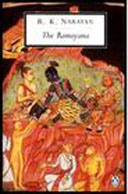
School: Boston College High School
Project Title: Ashrama, Dharma, Moksha: The Ramayana as a Metanarrative for Hindu Cosmology
|
My overall goal for preparing this lesson was to provide a preliminary set of textual and on-line resources for teaching Hinduism at the secondary level. Although the institute is a study of the cultures and religions of the Himalayan region, I found there was a need for Hindu resources in lesson planning. I wanted to examine how narratives can be used in the classroom by empowering students to read primary literature of the traditions they are studying; enabling teachers to create interdisciplinary lessons across departments (e.g., social studies, religion, art, literature); and establishing preliminary questions for further course development. I found the Ramayana to be the ideal text suited for such discussions and lesson planning. The Indian classic of heroism and ethics has found its place among the great narratives of the world--hence the term “metanarrative." I have based most of my evaluation and reflections on the translation of R.K. Narayan amidst the great diversity of translations and interpretations of this story.
Another benefit of using the Ramayana as an introduction to the Indic Valley is the manner in which it allows for a plethora of textual and moral interpretations while simultaneously explaining the core social and philosophical concepts within Hinduism; the analysis of the characters is as vast as its translations and commentaries. For my project, I have chosen three of these concepts as a means of framing my lesson construction and should not be taken in a superlative manner as if they are somehow more essential than others to understand Hindu literature or philosophy. Nevertheless, they do appear to provide a general template and foundation for understanding the rich literary heritage and theological complexity of this great faith tradition. In terms of pedagogy for the classroom, I have also created chapter questions (based on Narayan’s text) and a couple of suggested assignments that seek to create a sense of ownership on the part of the students who might read the Ramayana as part of a humanities course or as part of a larger unit on Indic Valley traditions. The quality of responses to these questions will demonstrate a level of comprehension that should be expected of secondary students. They will also integrate the salient points of how Hinduism understands human nature and its relation to nature and the world as a whole. Please feel free to contact me with further suggestions or feedback on readings and/or resources for teaching this epic narrative. |
|||||||||
This site was created by Patrick Tiernan at the NEH Summer Institute "Cultures and Religions of the Himalayan Region," held at the College of the Holy Cross, Summer 2006
